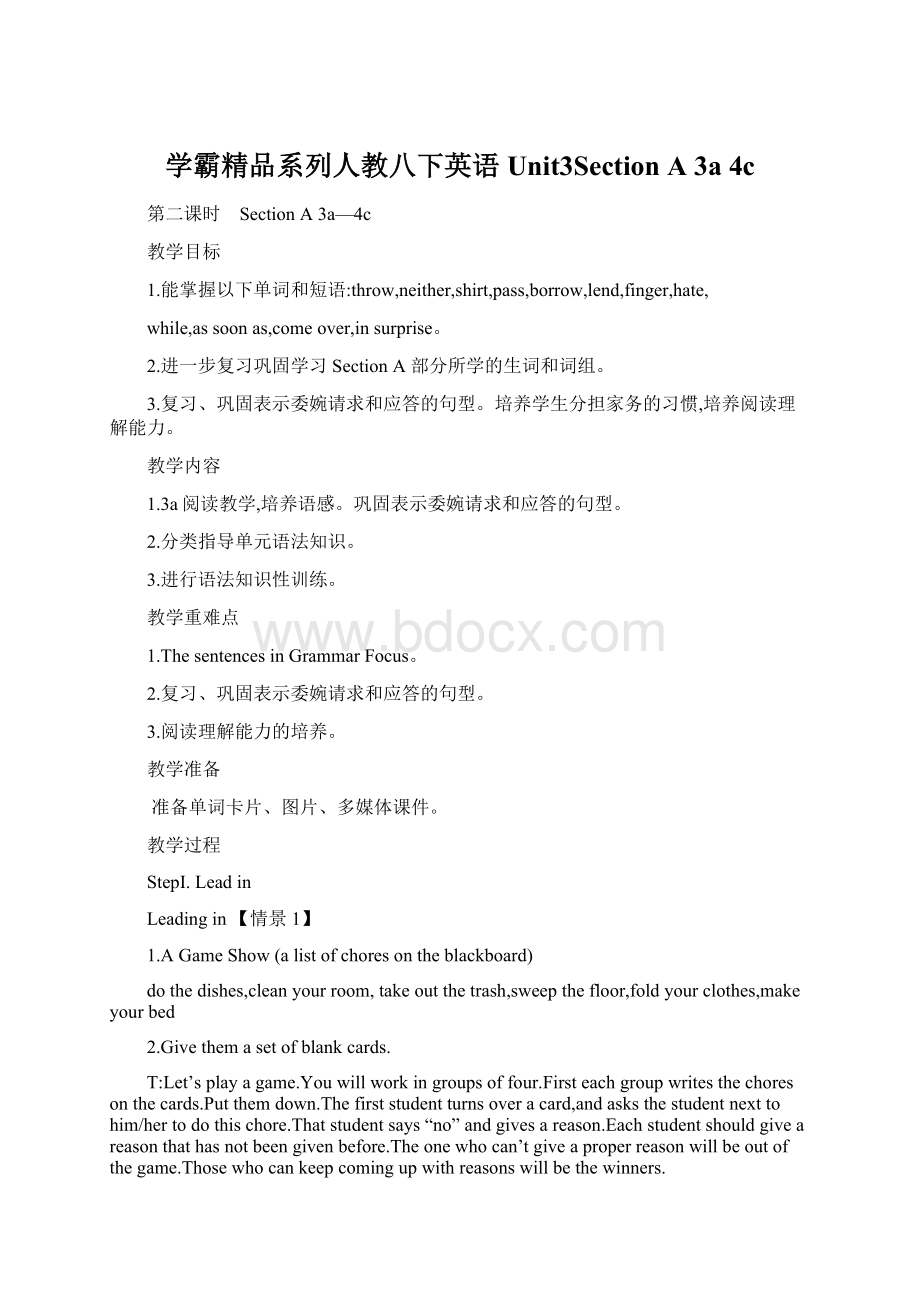学霸精品系列人教八下英语Unit3Section A 3a 4cWord文档下载推荐.docx
《学霸精品系列人教八下英语Unit3Section A 3a 4cWord文档下载推荐.docx》由会员分享,可在线阅读,更多相关《学霸精品系列人教八下英语Unit3Section A 3a 4cWord文档下载推荐.docx(10页珍藏版)》请在冰豆网上搜索。

1.ThesentencesinGrammarFocus。
2.复习、巩固表示委婉请求和应答的句型。
3.阅读理解能力的培养。
教学准备
准备单词卡片、图片、多媒体课件。
教学过程
StepⅠ.Leadin
Leadingin【情景1】
1.AGameShow(alistofchoresontheblackboard)
dothedishes,cleanyourroom,takeoutthetrash,sweepthefloor,foldyourclothes,makeyourbed
2.Givethemasetofblankcards.
T:
Let’splayagame.Youwillworkingroupsoffour.Firsteachgroupwritesthechoresonthecards.Putthemdown.Thefirststudentturnsoveracard,andasksthestudentnexttohim/hertodothischore.Thatstudentsays“no”andgivesareason.Eachstudentshouldgiveareasonthathasnotbeengivenbefore.Theonewhocan’tgiveaproperreasonwillbeoutofthegame.Thosewhocankeepcomingupwithreasonswillbethewinners.
3.T:
Nowwe’llreadNancy’sstory.Let’sseeNancy’sopinion.Cometo3aplease.
[设计意图] 通过游戏的方式复习上节学习的重点动词短语,为本节的话题学习自然导入新课。
Leadingin【情景2】
Boysandgirls!
Doyouoftendothechoresathome?
Ss:
...
Doyouoftensweepthefloor?
S1:
Whatotherchoresdoyouoftendo?
...
Whataboutyou?
S2:
Doyouthinkweshouldsharethechoresathome?
Nowwe’llreadNancy’sstory.Let’sseeNancy’sopinion.Cometo3aplease.
[设计意图] 通过与学生谈论有关做家务的话题,复习上节学习的关于家务的短语,导入新授。
StepⅡ.Readingactivities
Task1:
Readthearticlefastandfindthegeneralideaof3a.
Thearticleistalkingabout .
A.whentodothechores
B.whoshoulddothechores
C.howtodothechores
Task2:
Readthearticleandanswerthequestions.
1.WhywasNancy’smomangrywithher?
2.Didtheysolvetheproblem?
How?
3.WhatwasthefirstthingNancydidwhenshegothome?
4.DidNancydoanyhouseworkthatday?
Task3:
LetstudentsreadthepassageagainandwriteTrue(T)orFalse(F).
1.Nancy’sfatheraskedhertotakethedogforawalk.
2.Nancy’smotherdidn’tdothehouseworkforaweek.
3.Atlast,Nancyunderstandsthateachofthemneedstosharethehousework.
Theteachershouldexplainthesentencesandpoints.
☆教材解读☆
1.Ithrewdownmybagandwenttothelivingroom.
throwv.扔;
掷。
过去式是threw,过去分词是thrown。
throwsth.tosb.=throwsb.sth.将某物扔给某人;
throwsth.atsb.用某物砸某人;
throwaway扔掉,错过(机会等)。
It’stooheavy.Don’tthrowittome!
它太重了。
不要把它扔给我!
Theboysarethrowingstonesatthedog.
那些男孩在用石头砸狗。
Ineverthrowanythingaway.
我什么东西都不舍得扔。
2.I’mjustastiredasyouare!
as...as与……一样,表示两个人/物在某方面程度相同。
两个as中间是形容词或副词的原级。
当表示“甲方在某一方面不及乙方时”用“notas/so+形容词/副词的原级+as”结构。
Thetreeisastallasthebuilding(is).
这棵树和那栋楼一样高。
3....,shedidnotdoanyhouseworkandneitherdidI.
“neither+助动词/be动词/情态动词+主语”表示上句否定的情况也适合于后者。
“Neither+助动词/情态动词/be动词+主语I.”相当于“Meneither.”。
—Theydidn’twatchTVyesterday.
他们昨天没有看电视。
—Meneither./NeitherdidI.我也没看。
—Heisnotadoctor.他不是医生。
—Meneither./NeitheramI.
我也不是。
【拓展】
(1)“so+助动词/be动词/情态动词+主语”表示后面的主语“亦如此,也同样”,说明前面的肯定情况同样也适用后者。
表明前面的主语和后面的主语不是同一个人(物)。
—YouwatchedTVlastnight.
你们昨晚看了电视。
—Sodidthechildren.孩子们也看了。
Youcanswim.SocanI.
你会游泳。
我也会。
(2)“so+主语+助动词/be动词/情态动词”意为“正是那样,确实如此”,表示肯定上面的观点,前面的主语和后面的主语是同一个人(物)。
—TomspeaksChineseverywell.
汤姆讲汉语讲得很好。
—Sohedoes.
他的确是这样。
4....,Sheaskedinsurprise.
【辨析】insurprise,toone’ssurprise,besurprisedat
(1)insurprise惊奇地,是副词性短语,用来修饰动词,一般放在修饰的动词后面。
Thetwogirlslookedateachotherinsurprise.那两个女孩惊奇地相互看着。
(2)toone’ssurprise令人惊奇的是,one’s指形容词性物主代词或所有格,toone’ssurprise相当于“主语+be+surprised”。
Tohissurprise,hefoundthegirlwasverybeautiful.
=Hewassurprisedtofindthegirlwasverybeautiful.
令他惊奇的是,他发现这个女孩非常漂亮。
(3)besurprisedat对……感到惊奇,表示主语对某事或某物惊奇,surprised可以被very,too等修饰,作表语或定语。
Weareverysurprisedatthenews.
听到这个消息我们很诧异。
Task4:
Readthesentencesbelow.Underlinethesentencesfromthereadingthatmeanthesamething.
1.Neitherofusdidanyhouseworkforaweek.
2.MymomcameoverassoonasIsatdowninfrontoftheTV.
3.You’retired,butI’mtired,too.
Explainthepointstostudents.
1.Neitherofusdidanyhouseworkforaweek.
neither也不;
两者都不。
作主语时,谓语动词用单数形式。
Neitherofhisfriendsisrich.
他的两个朋友都不富裕。
【拓展】
(1)neither...nor意为“既不……也不……”。
本短语常连接两个相同的成分,连接并列主语时,谓语动词和靠近的主语一致。
NeitheryounorIamanactor.
你和我都不是演员。
NeitherInoryouareanactor.
(2)neither的反义词是both,意为“两者都”,所修饰的名词用复数形式。
either意为“两者中任一个”,作形容词时,所修饰的名词用单数。
【注意】 neither...nor和either...or在连接两个并列成分作主语时,谓语动词遵循“就近原则”。
NeitherInorsheknowsaboutit.
我和她都不知道那件事。
EitheryouorIamwrong.
不是你错,就是我错。
2.MymomcameoverassoonasIsatdowninfrontoftheTV.
assoonas一……就……,强调两个动作几乎是连在一起的,后接从句。
当主句是一般将来时,assoonas引导的状语从句应用一般现在时;
当主句是过去将来时,assoonas引导的状语从句应用一般过去时;
主句是过去时,从句也可以是过去时。
I’llwritetoyoua